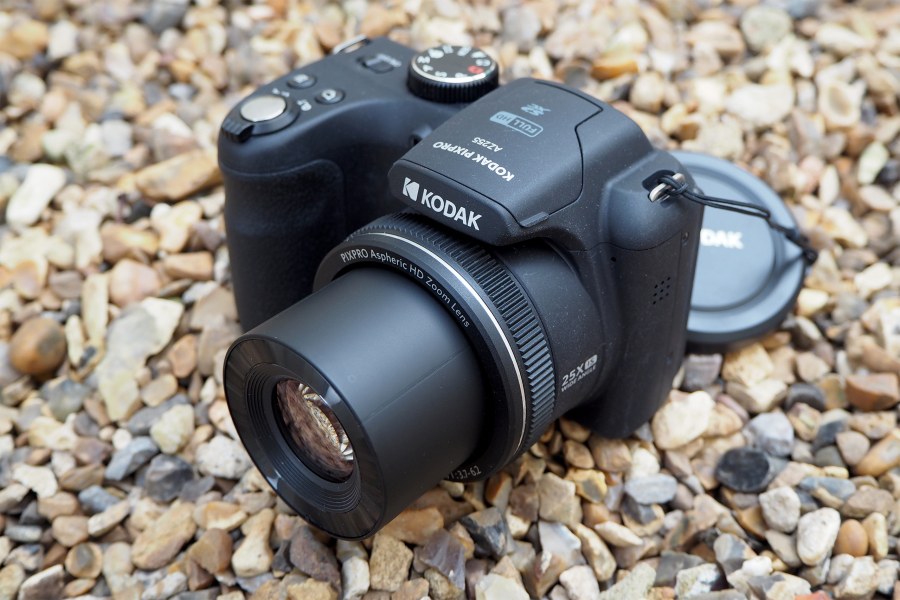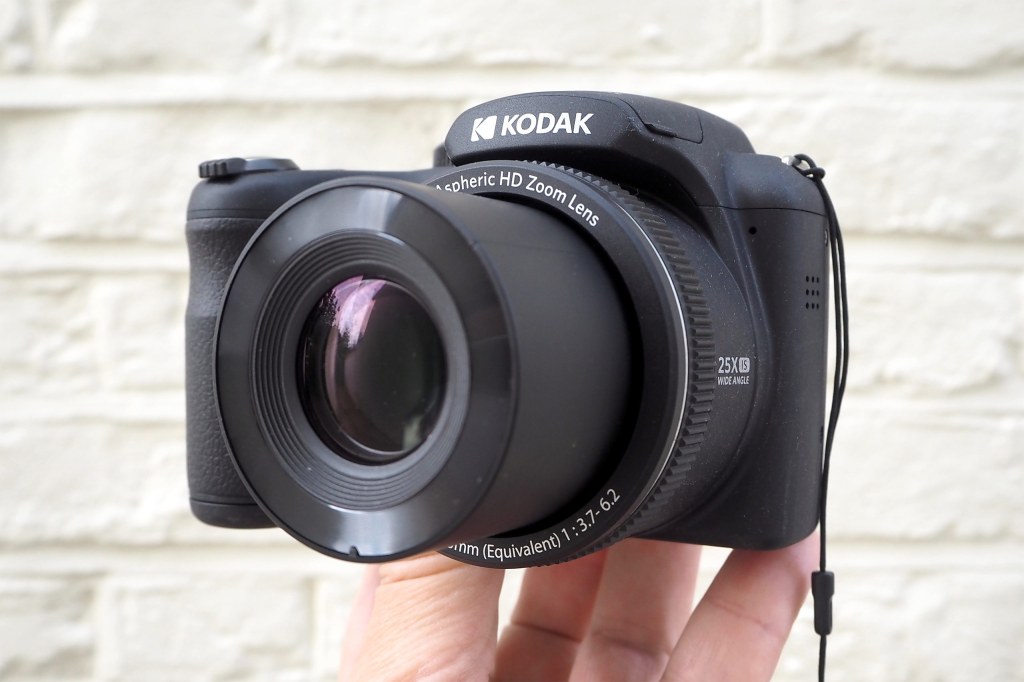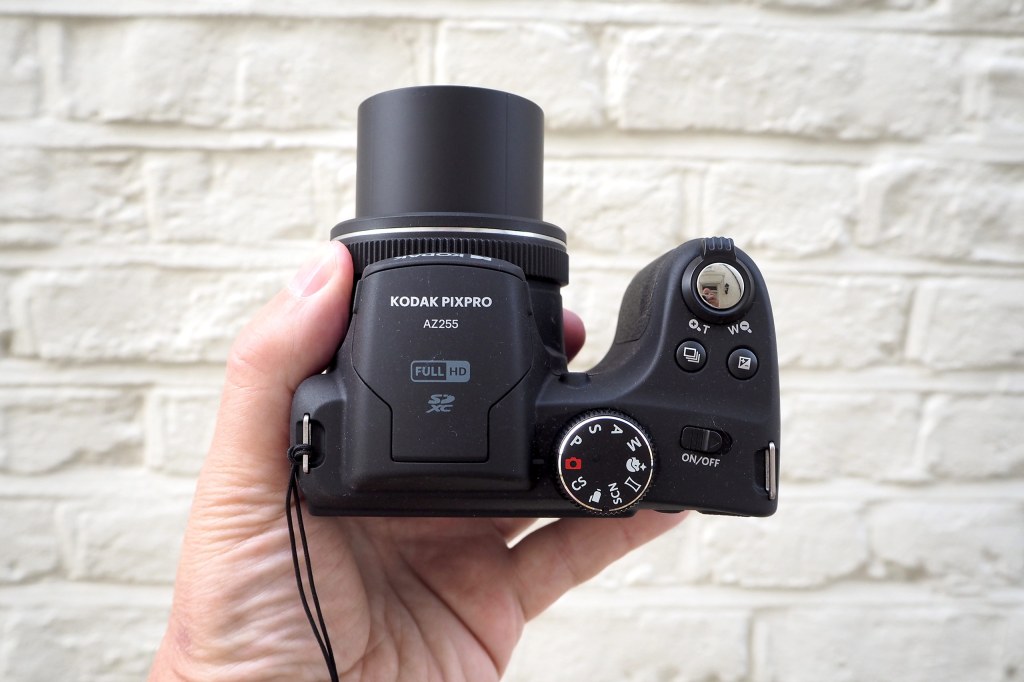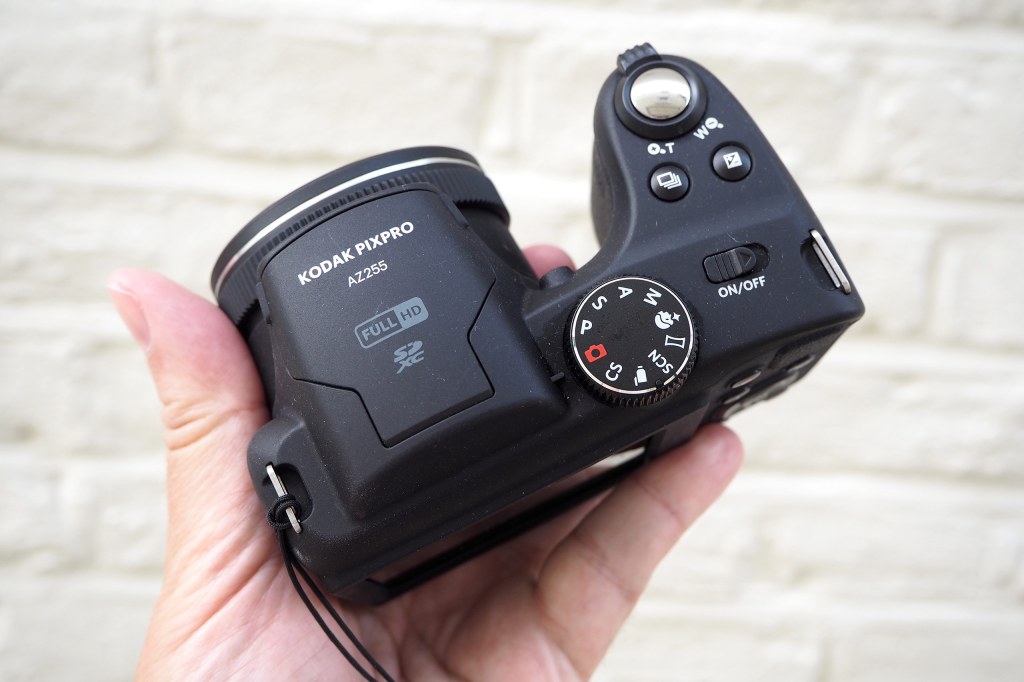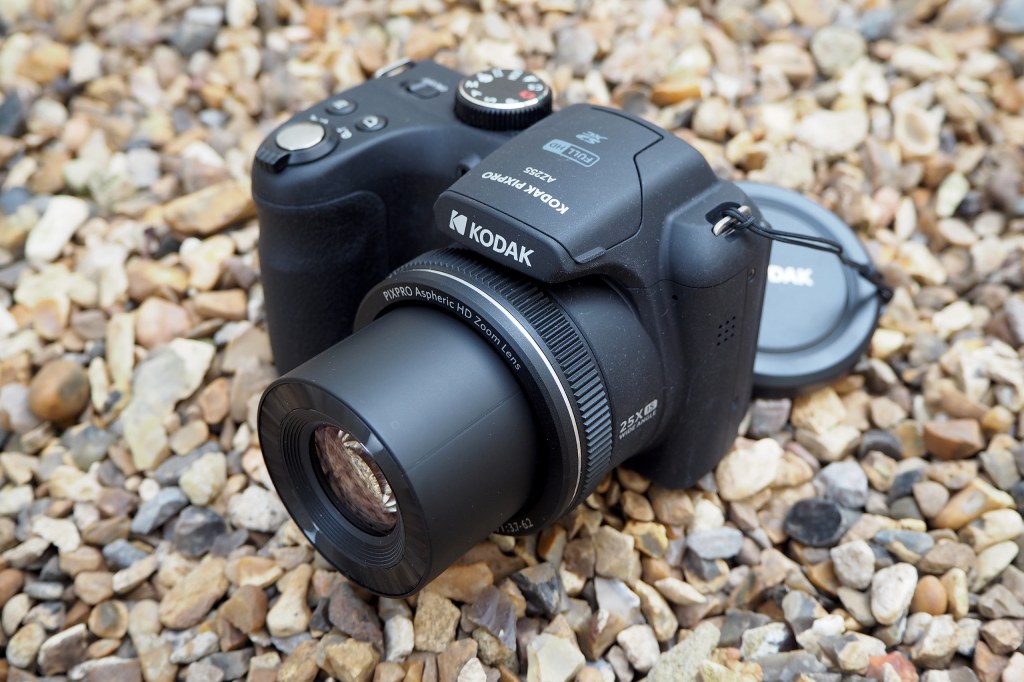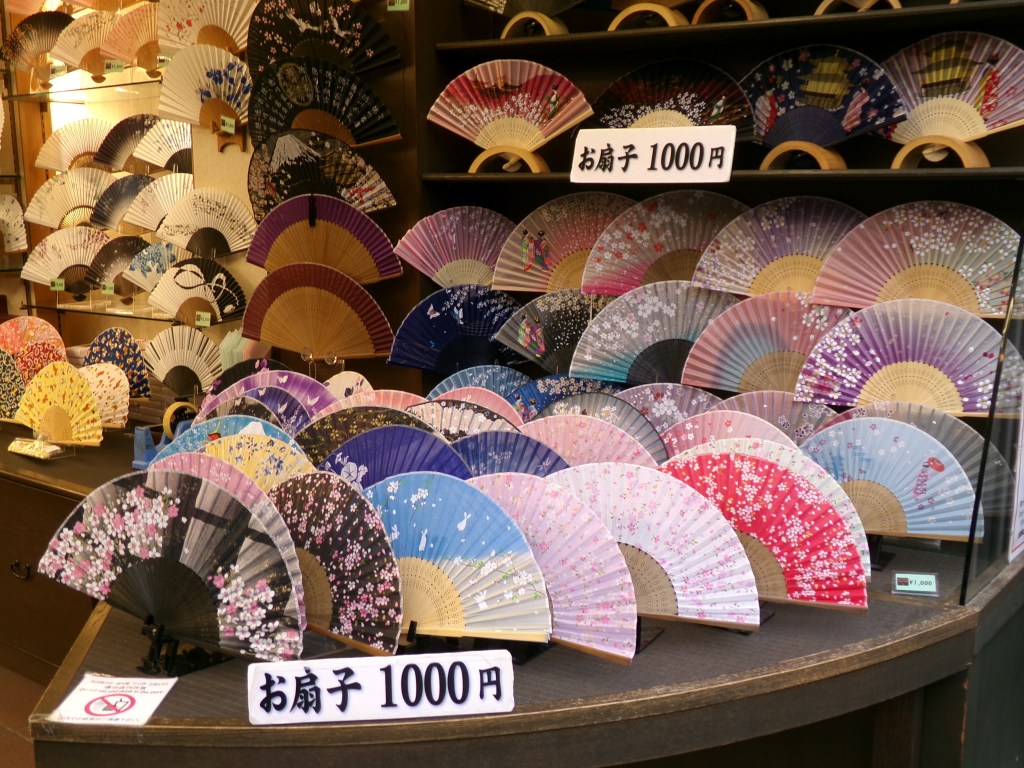Amateur Photographer verdict
The Kodak PixPro AZ255 may be cheap, but we’d suggest paying just a little extra and going for its 20MP, 40x optical zoom AZ405 bigger brother- Big zoom power in a relatively compact body
- Easy to grasp operation
- 4x AA batteries are easily replaceable in the field
- Reasonable build quality and feature set for price
- Visible purple fringing between areas of high contrast
- Slightly sluggish operation compared to others
- 25x optical zoom feels underpowered next to the 40x AZ405
- No built-in Wi-Fi
Kodak Pixpro AZ255 At a glance:
- 16MP 1/2.3-inch BSI CMOS sensor
- 25x optical zoom lens, f/3.7-f/6.2, 24-600mm equivalent
- 60cm to 250cm min focusing range, or 3cm macro at widest setting
- 3-inch LCD screen, 460K dots
- Built-in Optical Image Stabilisation
- Full HD 1920×1080 pixels at 30fps video recording
- Powered by 4x AA alkaline batteries, provided
- 114.3×81.6×84.4mm, 336g
- Available in black, red or white
- $149 / £179
Discovering a new digital bridge camera these days is like finding the proverbial needle in a haystack. Kodak product developer JK Imaging has an affordable entry-level option in the 16MP AZ255 however, as Gavin Stoker discovers, this camera may not be the best choice.
Once they were plentiful. But now that we’re some 15 years on from the height of their popularity, brand new bridge cameras, ultra zooms or all in ones – however you choose to term them – are a rare breed. The original premise was that cameras like the Kodak Pixpro AZ255 here were an option for families wanting the fuss free convenience of just one camera that would do it all. They also appealed to photo enthusiasts who desired the luxury of a broad focal range without having to keep changing the lens in use.
However, the original batch of bridge cameras were not without compromise. First of all the size of the sensor at their heart was smaller than that found in an outwardly similar DSLR, and in fact closer to, or exactly the same as, that found in a simple point-and-shoot compact. And then of course image quality from a relatively inexpensively priced zoom camera was never going to compete with a dedicated telephoto lens costing thousands and affixed to a DSLR or mirrorless camera with a larger sensor and better tech.
Still, as is the case with the Kodak Pixpro AZ255, the bridge camera’s advantage is that it can offer a more portable and less weighty set up than more ‘professional’ cameras, as well as a more affordable one. And yet, in 2024, when most of us are content with shooting snaps on our mobile phones, is there still a place, a market and a indeed need for an entry level bridge camera like this one? Read on and find out…
The real reason for any of us considering a Kodak Pixpro AZ255 is being able to use it to squeeze just about any and every subject into frame, without needing to switch camera or lenses. Here the 25x optical zoom provides the generous 35mm equivalent of a focal range stretching from an ultra wide 24mm setting to 600mm at the telephoto end. That’s great for landscapes, portraits, sight-seeing and just about everything else.
This non-interchangeable lens is coupled with a modest sized 1/2.3-inch back illuminated CMOS sensor that boasts a total of 16.76 million pixels, of which 16.35 million are effective. That’s the kind of specification that we were used to seeing from pocket-sized point and shoot cameras back in the day and, if not for the creative flexibility of the zoom lens it’s married to, wouldn’t normally be anything to get excited about.
However here we can part excuse such modest specification, on paper at least, due to both generous lens reach and the overall affordability of this camera. What has been sacrificed because of size and intended price point, however, and which we found ourselves more greatly missing, is an eye level viewfinder of any description. Here, just like on a point and shooter, images are composed and played back via a fixed, 3-inch backplate LCD.
Again the screen specification is modest, at just 460K dots in resolution, but it at least proves sufficient in determining whether our captured subject is in focus, once we’ve zoomed in to check. In strong sunlight however, as with most digital cameras, getting a clear view via the monitor proves more difficult and that’s when an eye level finder would have come to the rescue.
Additionally sacrificed to achieve a very affordable price is a lithium ion rechargeable battery, though fortunately four regular AAs that slot into the base of the handgrip are included. Once these expire, with an eye on a longer-term solution, we can swap them out for rechargeables should we wish to do so.
What are the other features of the Kodak Pixpro AZ255?
Shooting JPEG format-only when it comes to stills, there are three compression quality settings selectable in Best, Fine and Normal. Otherwise when it comes to video the camera can deliver up to a Full HD 1920×1080 pixels resolution at 30fps. There’s a dedicated video setting on the ridged top plate shooting mode dial that will be familiar to anyone who’s used a digital camera before. Otherwise it’s just a case of a thumb press of the red record button at the top edge of the backplate to commence filming.
Both formats are committed to removable SD card, for which we’ll unsurprisingly need to provide our own media. This shares space in the bottom of the handgrip next to the four AA batteries required for power. As with the slightly higher priced and higher powered AZ405, we get a very modest integral memory of 67MB, should Dad have forgot to pack a memory card when the camera’s first unwrapped on Christmas morning.
How is the Kodak Pixpro AZ255’s Handling and design?
The design here resembles a DSLR in miniature, subtly suggesting that the camera is more fully featured and ‘professional’ perhaps than it actually is. The grip is big and fulsome, enabling a steady hold when shooting towards maximum telephoto setting, which is exactly how we’d want the camera to handle.
It’s really a bridge camera best suited to beginners however, with little in the way of any more manual controls than a point and shoot compact would typically furnish us with. Yes, we can switch between metering options, choose single shot or continuous AF, adjust resolution and access an HDR mode should we wish, but that’s about it.
Ranged around the shooting mode dial atop the camera are the familiar likes of the standard P, A, S, M settings, portrait mode, panorama mode, scene mode, video more, a custom settings mode, and full auto; exactly the same line up of options as provided by the alternative AZ405 camera and most common-or-garden compacts.
Kodak Pixpro AZ255 Performance
With AA batteries loaded, a thumb flick of the on/off switch on the top plate and the Kodak Pixpro AZ255 bursts into life within 2-3 seconds, the lens travelling to maximum wide-angle setting ready for action, while the 3-inch backplate LCD screen blinks into life.
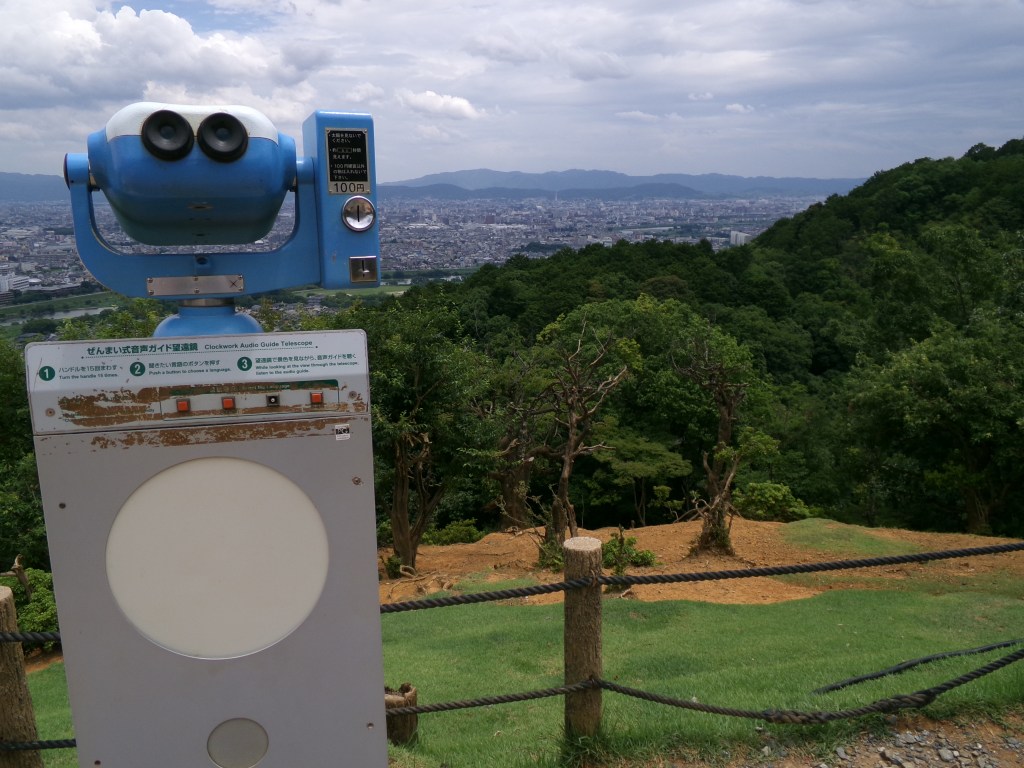
Accompanied by a buzz of internal mechanics, a nudge of the zoom lever encircling the raised shutter release button and the lens travels from its starting point to maximum 25x telephoto setting in around four to five seconds, the exact same time as the alternative AZ405 takes to arrive at its own maximum 40x zoom setting.

As we’d expect from any camera to bear the Kodak branding, JPEG files straight out of the AZ255 are well saturated and colour rich, though on the downside we did get instances of visible purple pixel fringing and shots taken towards maximum telephoto can be distinctly soft in appearance.
Should we wish for a steadier result than our own hand holding plus the built-in optical image stabilisation here can provide, there is actually a screw thread located at the base of the camera for a tripod attachment.

Is the Kodak Pixpro AZ255 Value for money?
On the face of it the AZ255 appears great value and indeed we are getting a lot of camera for a very reasonable outlay. However, it doesn’t offer as good value as its 40x optical zoom, 20MP AZ405 sibling, which costs just $30 / £20 more and provides greater scope overall. We’re pleased that we do get a quartet of AA batteries provided out of the box to start things off, along with a slide-on plastic lens cap that can be tethered to a lug at the side of the camera to stop said cap getting lost. There’s also a neck or shoulder strap provided in the box, so there is really not much cause for complaint in terms of included accessories.
Final Verdict on the Kodak Pixpro AZ255
While it does not break any new ground as regards provided technology or performance, the Kodak Pixpro AZ255 will give the user an introduction to what a bridge camera is capable of, in delivering a broad and useful optical zoom reach that very much sets it apart from what we could otherwise achieve with just our smartphone. Don’t go into this one expecting the sort of image quality that a mirrorless camera, older DSLR, or large sensor compact might deliver, and at this keen price point, there will be little room for buyer remorse.
Offering easy-to-grasp operation and a big zoom lens to pull the action closer to us from afar, the Kodak Pixpro AZ255 presents itself as a jack-of-all-trades capture device. Unless your bridge camera budget is particularly tight, however, we’d suggest paying just a little extra and going for its 20MP, 40x optical zoom AZ405 bigger brother. For us, that alternative is just a little ahead on image quality as well as lens reach and worth its modest price increase.
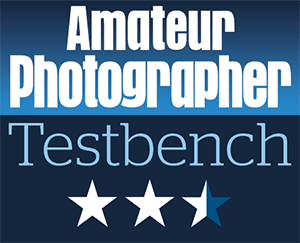
Follow AP on Facebook, Twitter, Instagram, YouTube and TikTok.
How does the Kodak Pixpro AZ255 compare to its AZ405?
In having a smaller 25x optical zoom in comparison with the outwardly similar looking 40x optical zoom Kodak Pixpro AZ405, its little brother in the AZ255 is lighter at a body-only weight of 336g compared with 436g. In terms of overall measurements the AZ255 body is not quite as deep as its bigger sibling either, again because of the smaller lens. Overall dimensions are 113.6×77.7×69.7mm, compared with the higher priced AZ405’s 114.3×81.6×84.4mm.

With the exterior of both cameras resembling miniature DSLRs rather than the compacts the controls and operation here may more closely resemble, the built-in flash just above the lens on the AZ255 needs to be raised by hand, whereas on the AZ405 it springs automatically into action with a button press.
But lens reach aside, the other important difference between the two models is whereas the AZ255 has a 16MP top resolution setting, on the AZ405 this is increased to a more generous and in our opinion slightly better detailed 20 megapixels. Instances of pixel fringing between high contrast areas of an image were also more easily noticeable on the AZ255. So our advice would be to aim for the Kodak Pixpro AZ405 if you can afford it.
For more options, have a look at the best ultra zoom bridge cameras.

